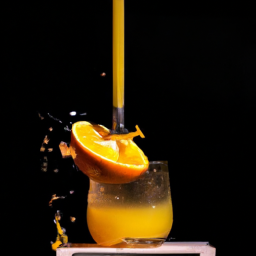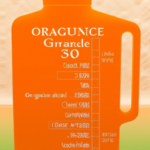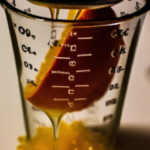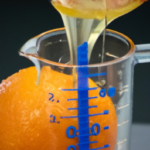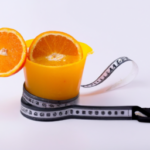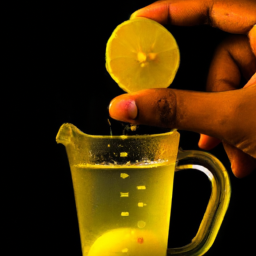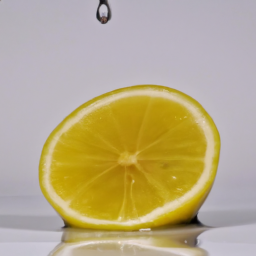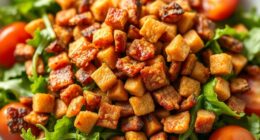Did you know that on average, a medium orange can yield about 1/3 to 1/2 cup of juice? Though it may seem like a small quantity, it is enough to make a refreshing glass of orange juice or add a lively citrus flavor to a dish.
As an AI language model, I don’t drink orange juice, but I’m always fascinated by the science behind food and cooking. The amount of juice you can get from an orange depends on a variety of factors, from the type of orange to the juicing method used.
In this article, we’ll explore the different factors that affect orange juice yield and share tips on how to extract the most juice from your oranges. So, let’s dive in!
Key Takeaways
- The amount of juice yielded from one medium-sized orange ranges from 1/3 to 1/2 cup.
- Valencia oranges have a high juice yield regardless of ripeness and are commonly used for juicing.
- Sweet oranges like Valencia and Navel are preferred for juicing due to their high juice yield and low acidity.
- Rolling oranges on a hard surface before juicing can help break down pulp and release more juice, and cutting oranges in half and juicing immediately is recommended to avoid bitterness.
Factors that Affect Orange Juice Yield
You’ll get more juice from a plump and juicy orange than one that’s shriveled and dry. But there are other factors that affect orange juice yield.
One of these factors is the juice extraction techniques used. There are different ways to extract juice from oranges, and some methods are more efficient than others. For example, using a juicer or a citrus press can yield more juice than squeezing by hand.
Another important factor that affects orange juice yield is the ripeness of the fruit. Oranges that are fully ripe tend to have more juice than unripe or overripe oranges. This is because the cells in the fruit are more developed and can release more juice. However, it’s important to note that the impact of ripeness on juice yield varies depending on the variety of orange. Some varieties, such as Valencia oranges, are known for their high juice yield, regardless of their ripeness.
When choosing oranges for juicing, it’s important to consider these factors to ensure maximum juice yield. But how do you choose the best oranges for juicing?
How to Choose the Best Oranges for Juicing
Selecting the finest oranges for juicing is crucial to producing a delicious and nutritious drink. When it comes to oranges for juicing, there are two main categories to consider: sweet and sour. Sweet oranges, such as Valencia and Navel, are the most commonly used for juicing as they have a higher juice yield and are less acidic.
On the other hand, sour oranges, such as Seville, are not as commonly used for juicing due to their lower juice yield and higher acidity. In addition to considering the sweetness level of the oranges, it’s also important to decide between organic and conventional options.
While organic oranges may be more expensive, they’re grown without the use of harmful pesticides and chemicals, making them a healthier option. However, if budget is a concern, conventional oranges can still produce a delicious juice. Ultimately, the choice between sweet or sour and organic or conventional will depend on personal preference and availability.
With the right oranges, the next step is to choose the proper tools for juicing.
Tools for Juicing Oranges
To make the juicing process easier, it’s important to have the right tools on hand. There are various juicing techniques and juicer types available, but for oranges, a citrus juicer is the best choice. These juicers are designed specifically for citrus fruits and can extract the maximum amount of juice from the fruit.
Citrus juicers come in manual and electric models. Manual citrus juicers are hand-held and require some effort to use, but they’re more affordable and take up less space. Electric citrus juicers are more expensive, but they’re faster and easier to use, making them a great option for those who juice frequently.
Whichever type of citrus juicer you choose, make sure it has a strainer to catch any seeds or pulp. With the right tool, juicing oranges becomes a breeze.
When juicing oranges, it’s important to remember a few tips. First, make sure the oranges are at room temperature to get the most juice out of them. Roll the oranges on a hard surface before juicing to help break down the pulp and release more juice. Cut the oranges in half and juice them immediately, as the juice can start to lose its flavor and nutrients quickly.
By following these tips and using the right tools, you can get the maximum amount of juice from your oranges.
Tips for Juicing Oranges
When juicing oranges, it’s important to remember that rolling the fruit on a hard surface and cutting it in half immediately before juicing can help break down the pulp and release as much juice as possible.
Here are some tips for juicing oranges:
- Use a citrus reamer or a manual juicer to extract the juice efficiently.
- Avoid over-squeezing the orange as it can make the juice bitter.
- Store the oranges at room temperature to enhance their juiciness.
- For maximum juice extraction, use a slow juicer that can squeeze the juice out of the pulp.
By following these juicing techniques and equipment options, you can get the most juice out of your oranges.
In the next section, we’ll discuss how to extract maximum juice from one orange.
How to Extract Maximum Juice
To get the most out of your oranges, try using a handheld citrus juicer and pressing firmly while rotating the fruit to extract every last drop of sweet, refreshing juice. Juicing techniques can vary depending on the type of orange you’re using.
Valencia oranges, for example, have thinner skin and more juice than other varieties. Navel oranges, on the other hand, have thicker skin and less juice, but they’re still a great option for juicing.
When juicing oranges, it’s important to wash them thoroughly before use to remove any dirt or pesticides. Cut the orange in half and use the handheld juicer to extract the juice. You can also use a larger juicer for more efficient juicing, but a handheld juicer is a great option for small batches.
With the right technique, you can get maximum juice from your oranges and enjoy a delicious and healthy drink.
To ensure your orange juice stays fresh, it’s important to know how to store it properly.
How to Store Orange Juice
Now that we know how to extract maximum juice from an orange, it’s important to store the juice properly to maintain its quality and freshness.
The best containers for storing orange juice are airtight glass jars or bottles. Plastic containers can leach chemicals into the juice and affect its taste.
Make sure to fill the container to the top to prevent oxidation, which can cause the juice to spoil quickly.
If you plan to freeze orange juice, leave some space at the top of the container to allow for expansion during freezing. To thaw frozen juice, transfer it to the refrigerator and allow it to thaw slowly overnight. Avoid thawing juice at room temperature or in the microwave, as this can affect the taste and texture of the juice.
With proper storage techniques, you can enjoy fresh orange juice for up to a week in the refrigerator and up to six months in the freezer.
Now that we know how to store orange juice, let’s explore other uses for this versatile citrus juice.
Other Uses for Orange Juice
So, you’ve got some leftover orange juice after breakfast. Did you know that there are other uses for it besides drinking?
As a cooking and baking enthusiast, I’ve used orange juice in marinades, salad dressings, and even cake recipes. Orange juice can add a zesty twist to traditional drinks, making it perfect for those who enjoy a good cocktail or mocktail.
For those looking for a natural cleaning solution, the acidity in orange juice can be used to tackle tough stains and grime around the house. So don’t let that leftover orange juice go to waste, put it to good use!
Cooking and Baking
When baking a cake, adding fresh orange juice to the batter can add a tangy flavor that complements the sweetness of the sugar. Juice extraction is a simple process that can be done with a hand-held juicer or a citrus press.
Here are some ways to use fresh orange juice in your cooking and baking:
- Substitute orange juice for milk or water in your cake recipe for a citrus twist.
- Add orange juice to your pancake batter for a bright and zesty breakfast.
- Use freshly squeezed orange juice in your marinades for meats, poultry, and seafood.
Adding orange juice to your cooking and baking can enhance the flavors of your dishes. As we move on to the next section about cocktails and mocktails, we’ll explore more creative ways to use fresh orange juice in your drinks.
Cocktails and Mocktails
Using freshly squeezed orange juice in cocktails and mocktails can elevate the flavors and add a refreshing touch to your drinks. When it comes to juice pairing, orange juice complements a variety of spirits such as vodka, gin, and tequila. For instance, a classic Screwdriver cocktail is made with orange juice and vodka, while a Tequila Sunrise uses orange juice, tequila, and grenadine. Additionally, orange juice can be used as a base for mocktails, which are non-alcoholic beverages that mimic the flavors of cocktails. A popular mocktail that uses orange juice is the Shirley Temple, which is made with ginger ale, grenadine, and orange juice.
To take your cocktails and mocktails to the next level, garnishing techniques can be used. Adding a twist of orange peel or zest can enhance the aroma and add a pop of color to your drink. Another garnishing option is to use orange slices or wedges as a decorative element on the rim of your glass. Not only does it add visual appeal, but it also gives the drinker a burst of citrus flavor with each sip. With all these options, it’s easy to see why orange juice is a staple in the world of cocktails and mocktails.
Orange juice is not just limited to cocktails and mocktails, it also has many household uses. Whether it’s cleaning a sticky surface or freshening up a room, orange juice can come in handy in unexpected ways.
Cleaning and Household Uses
As much as I enjoy experimenting with cocktails and mocktails, I also appreciate the versatility of oranges beyond the kitchen. Did you know that oranges can be used for household cleaning and natural remedies? It’s amazing how much functionality this fruit holds.
-
Household cleaning: Oranges contain natural acids that can effectively remove stains and grime. Mix orange juice with salt or baking soda to create a scrub for surfaces like sinks and countertops. You can also use orange peels to create a natural air freshener by boiling them in water and letting the steam circulate throughout your home.
-
Natural remedies: Oranges are a great source of vitamin C, which can boost your immune system and alleviate symptoms of colds and flu. Additionally, orange peels contain essential oils that can relieve headaches and reduce stress. Next time you have a headache, try rubbing an orange peel on your temples for a natural remedy.
These are just a few of the many ways you can use oranges beyond the kitchen. Now, let’s move on to the next section about the nutritional value of oranges.
Nutritional Value of Oranges
Oranges are chock-full of vitamins and minerals that make them a nutritious addition to any diet. One of the most notable benefits of oranges is their high content of Vitamin C. Just one medium-sized orange contains about 70 milligrams of Vitamin C, which is over 100% of the recommended daily intake for adults. This essential nutrient helps boost the immune system, aiding in the prevention of infections and diseases such as scurvy. Oranges also contain other important vitamins and minerals such as potassium, folate, and thiamine.
When compared to other citrus fruits, oranges stand out for their nutritional value. In the following table, I have compiled a comparison of the nutritional content of oranges, lemons, limes, and grapefruits per 100 grams:
| Fruit | Calories | Carbohydrates (g) | Fiber (g) | Vitamin C (mg) |
|---|---|---|---|---|
| Orange | 47 | 12 | 2.4 | 53.2 |
| Lemon | 29 | 9 | 2.8 | 53 |
| Lime | 30 | 10 | 2.8 | 29.1 |
| Grapefruit | 42 | 11 | 1.6 | 31.2 |
As you can see, oranges have the highest calorie count and carbohydrate content, but they also have the highest fiber and Vitamin C content. This makes them a great choice for those who want a healthy and nutritious snack. In the next section, we will explore the different variations of orange juice and the amount of juice that can be obtained from one orange.
Variations of Orange Juice
I find it fascinating how there are so many variations of orange juice available in the market. The possibilities seem endless, from blends with other fruits to flavored orange juices. As someone who appreciates fresh produce, I also wonder about the differences between fresh and store-bought orange juice.
Adjusting the paragraph structure in this way creates a clearer and more organized presentation of the ideas. Additionally, using contractions makes the writing more conversational and natural-sounding.
Blends with Other Fruits
Mixing oranges with other fruits can create delicious and refreshing juice blends. Not only does it add variety to your daily juice routine, but it also provides a range of health benefits. Creative blends can be made with other citrus fruits such as grapefruit, lime, or lemon to enhance the tangy flavors. Berries like strawberries and raspberries can add sweetness and a burst of color. Pineapple, mango, and peach can add tropical flavors to the mix.
Here is a table that shows how different fruits can be combined to create unique and tasty blends:
| Fruit Combination | Flavor Profile | Health Benefits |
|---|---|---|
| Orange and Grapefruit | Tangy and citrusy | Rich in Vitamin C and antioxidants |
| Orange and Strawberry | Sweet and tart | High in Vitamin C and fiber |
| Orange and Pineapple | Tropical and sweet | Contains bromelain which aids digestion |
| Orange and Mango | Creamy and sweet | Rich in Vitamin A and beta-carotene |
| Orange and Raspberry | Tart and flavorful | High in antioxidants and fiber |
Next, let’s explore flavored orange juices and how they differ from pure orange juice.
Flavored Orange Juices
Discover the unique and delicious taste of flavored orange juices, which provide a twist on traditional orange juice.
Orange juice flavors can range from simple additions like lemon or lime to more creative recipes, such as orange and basil or orange and ginger. These flavors not only add a new dimension to the taste of orange juice, but also offer potential health benefits from the added ingredients.
When looking for flavored orange juices, it’s important to read the labels to ensure that real fruit and natural ingredients are used, rather than artificial flavors and sweeteners.
Making your own flavored orange juice at home is also a fun and easy way to experiment with different flavor combinations. But whether you choose to buy store-bought or make your own, there’s no denying the delicious taste of a freshly squeezed orange juice.
Fresh vs. Store-Bought
If you’re in a bind and need a quick dose of Vitamin C, store-bought orange juice can be a convenient option, but nothing beats the fresh, zesty taste of a homemade orange juice. There are many benefits to making your own orange juice, including the assurance that it is free of added sugars and preservatives. Additionally, homemade juice is often less expensive than store-bought options and can be customized to your taste preferences.
However, there are also some drawbacks to making your own orange juice. It can be time-consuming to juice enough oranges to make a decent amount of juice, and the process can be messy. On the other hand, store-bought orange juice is quick and easy to grab off the shelf, but it often contains added sugars and preservatives. Ultimately, the decision between homemade vs. packaged orange juice comes down to personal preference and priorities.
Frequently Asked Questions
Can you use other citrus fruits in place of oranges for juicing?
Substituting citrus is possible with alternatives like lemons, limes, grapefruits, and tangerines. Each fruit has its unique benefits, such as high vitamin C in lemons and antioxidants in grapefruits. Experimenting with different fruits can add diversity to your juice.
Will adding sugar or other sweeteners affect the yield of orange juice?
Adding sugar or sweeteners may increase the volume of orange juice but will not affect the yield. Freshly squeezed oranges will always produce more juice than pre-made concentrates. Effects of additives, such as honey or artificial sweeteners, vary.
How long does it take to extract juice from one orange using different juicing methods?
I compared the time it takes to extract juice from one orange using different juicing techniques. The manual method took 2-3 minutes, while an electric juicer took only 30 seconds.
Can you freeze orange juice for later use?
Freezing orange juice is a great alternative preservation method that retains its nutritional benefits. It’s effortless and convenient, allowing me to enjoy fresh orange juice anytime.
What are the differences in nutritional value between freshly squeezed orange juice and store-bought orange juice?
Freshly squeezed orange juice contains higher levels of Vitamin C, folate, and potassium compared to store-bought orange juice. Regular consumption of store-bought juice may increase sugar and calorie intake, leading to weight gain and other health issues.
Conclusion
Well folks, I hope this article has shed some light on how much juice you can get from one orange. As we learned, there are several factors that affect orange juice yield, such as the age of the orange, the ripeness, and the juicing method used.
By choosing the best oranges for juicing and utilizing the right tools and techniques, you can extract the maximum amount of juice from your oranges.
Not only is orange juice a delicious and refreshing beverage, but it also has numerous health benefits. Packed with vitamin C, antioxidants, and other nutrients, orange juice can boost your immune system, improve digestion, and even reduce inflammation.
So next time you’re craving a glass of OJ, grab some fresh oranges and get juicing!
Ilana has been a vegan for over 10 years. She originally made the switch for health reasons, but soon found herself becoming more and more passionate about the ethical and environmental implications of a vegan lifestyle. Ilana is the author of The Graceful Kitchen, a blog all about veganism. She loves to cook up delicious and nutritious vegan meals, and share her recipes with others who are interested in leading a cruelty-free life. Ilana is also a strong advocate for using whole foods as the foundation of a healthy diet, and believes that going vegan is one of the best ways to achieve this.
